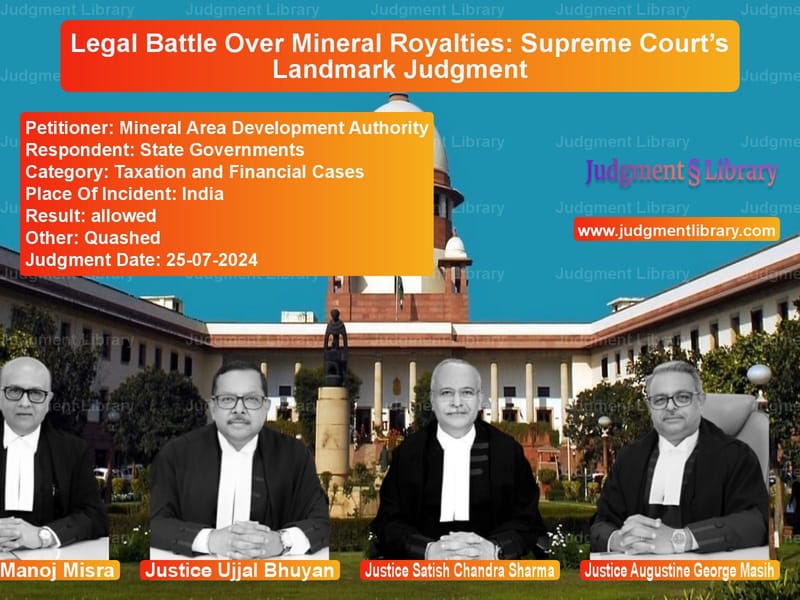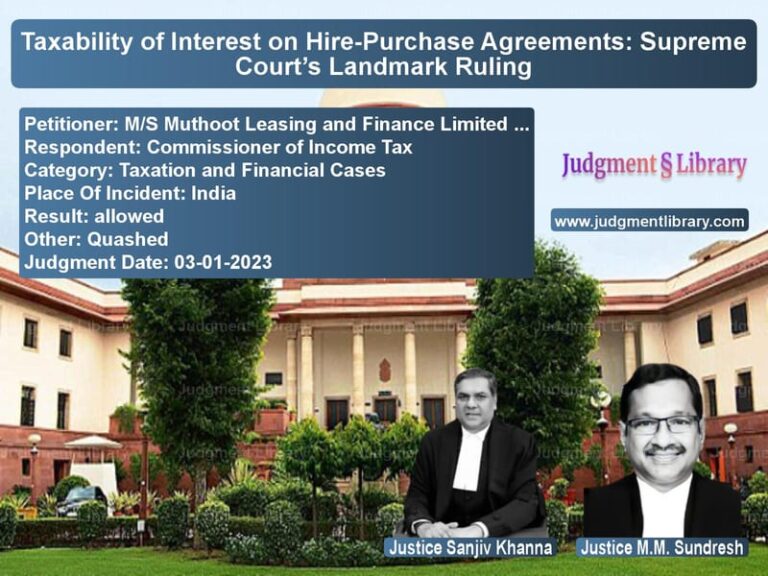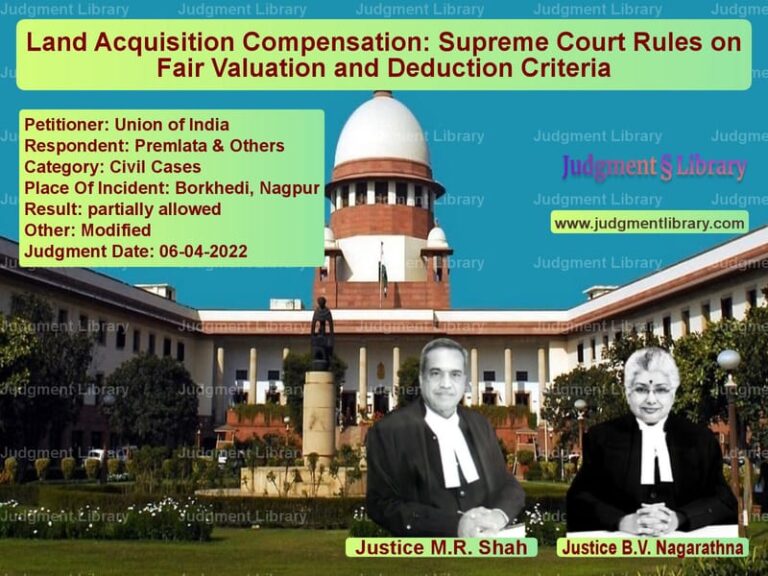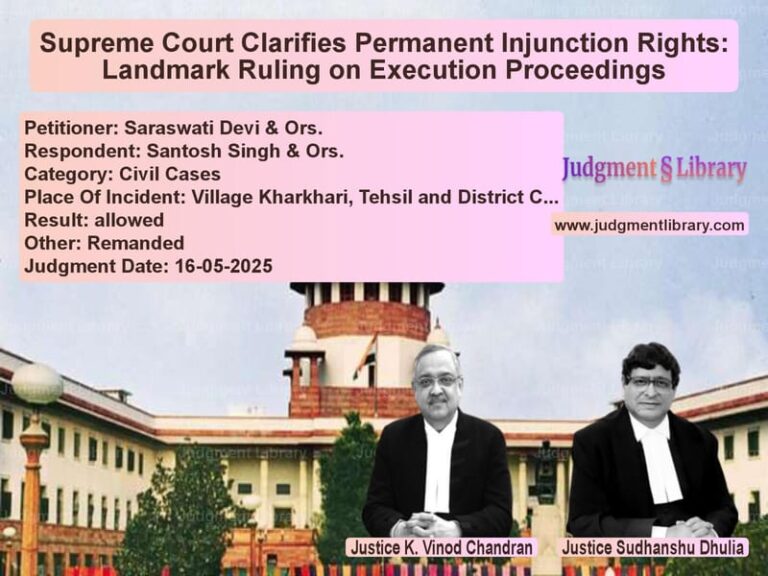Legal Battle Over Mineral Royalties: Supreme Court’s Landmark Judgment
The case at hand concerns the complex interplay between legislative powers, taxation, and mineral rights in India. The dispute revolves around whether the royalty imposed on minerals should be considered a tax, and whether state governments have the legislative competence to impose levies beyond what is prescribed under the Mines and Minerals (Development and Regulation) Act, 1957 (MMDR Act). This Supreme Court judgment provides clarity on the constitutional aspects of taxation, regulatory controls, and the autonomy of states in levying charges on mineral resources.
Background of the Case
The petitioner, Mineral Area Development Authority, challenged the imposition of additional levies and taxes on mineral royalties, arguing that the states lacked the legislative competence to do so under the constitutional scheme. The respondents, which included various state governments, contended that the levies were valid and that royalty was not a tax but rather a fee for the use of natural resources.
Petitioner’s Arguments
- The petitioner contended that royalty on minerals is essentially a tax and falls under Entry 50 of List II in the Seventh Schedule of the Constitution, which deals with taxation on mineral rights.
- It was argued that the states had no authority to impose additional levies beyond what was prescribed under the MMDR Act, as the regulation of mines and mineral development fell under Entry 54 of List I, which is within the exclusive jurisdiction of Parliament.
- Reliance was placed on previous judgments, including India Cement Ltd. vs. State of Tamil Nadu, where it was held that royalty is a tax, and thus, cess on royalty imposed by states was beyond their legislative competence.
- The petitioner further argued that the majority judgment in the Kesoram Industries case incorrectly interpreted the law by concluding that royalty is not a tax.
Respondent’s Arguments
- The respondents argued that royalty is not a tax but a payment for the right to extract minerals.
- They contended that Entry 50 of List II specifically empowers states to impose taxes on mineral rights, subject to limitations imposed by Parliament.
- It was submitted that states have historically imposed levies and cess on royalty, and such practices have been upheld by various courts in the past.
- The respondents relied on Kesoram Industries Ltd. vs. State of West Bengal, where it was held that royalty is a contractual payment and not a tax.
Key Issues Before the Court
- Whether royalty on minerals is a tax or a fee for resource utilization.
- Whether the states have the legislative competence to impose additional levies on mineral royalties beyond what is prescribed under the MMDR Act.
- Whether the judgment in Kesoram Industries should be upheld or overruled.
Court’s Observations and Findings
The Supreme Court meticulously analyzed the legislative entries and previous judicial pronouncements. The Court made the following key observations:
- Royalty is in the nature of a “tax” and not merely a payment for resource extraction.
- The MMDR Act, enacted under Entry 54 of List I, occupies the entire field of mineral regulation, and states cannot impose levies beyond what is prescribed therein.
- The judgment in Kesoram Industries was found to be flawed as it failed to appreciate the reasoning in India Cement and other precedents.
- The Constitution clearly limits the power of states in taxing mineral rights, making additional levies beyond those prescribed by Parliament unconstitutional.
Final Judgment
After considering the submissions, the Supreme Court ruled in favor of the petitioners. The Court held that:
- States do not have the legislative competence to impose additional levies on mineral royalties.
- The judgment in Kesoram Industries was overruled to the extent that it held that royalty is not a tax.
- The states must abide by the regulatory framework established under the MMDR Act.
- Any excess amounts collected by states in contravention of the law must be refunded or adjusted.
Conclusion
This landmark ruling clarifies the constitutional position on mineral taxation and state powers. By reinforcing the supremacy of the MMDR Act and the role of Parliament in regulating mineral development, the judgment ensures a uniform and consistent legal framework for taxation and resource management in the country.
Petitioner Name: Mineral Area Development Authority.Respondent Name: State Governments.Judgment By: Justice Dhananjaya Y Chandrachud, Justice Hrishikesh Roy, Justice Abhay S Oka, Justice J B Pardiwala, Justice Manoj Misra, Justice Ujjal Bhuyan, Justice Satish Chandra Sharma, Justice Augustine George Masih.Place Of Incident: India.Judgment Date: 25-07-2024.
Don’t miss out on the full details! Download the complete judgment in PDF format below and gain valuable insights instantly!
Download Judgment: mineral-area-develop-vs-state-governments-supreme-court-of-india-judgment-dated-25-07-2024.pdf
Directly Download Judgment: Directly download this Judgment
See all petitions in Income Tax Disputes
See all petitions in Tax Evasion Cases
See all petitions in Banking Regulations
See all petitions in Judgment by Dhananjaya Y Chandrachud
See all petitions in Judgment by Hrishikesh Roy
See all petitions in Judgment by Abhay S. Oka
See all petitions in Judgment by J.B. Pardiwala
See all petitions in Judgment by Manoj Misra
See all petitions in Judgment by Ujjal Bhuyan
See all petitions in Judgment by Satish Chandra Sharma
See all petitions in Judgment by Augustine George Masih
See all petitions in allowed
See all petitions in Quashed
See all petitions in supreme court of India judgments July 2024
See all petitions in 2024 judgments
See all posts in Taxation and Financial Cases Category
See all allowed petitions in Taxation and Financial Cases Category
See all Dismissed petitions in Taxation and Financial Cases Category
See all partially allowed petitions in Taxation and Financial Cases Category







